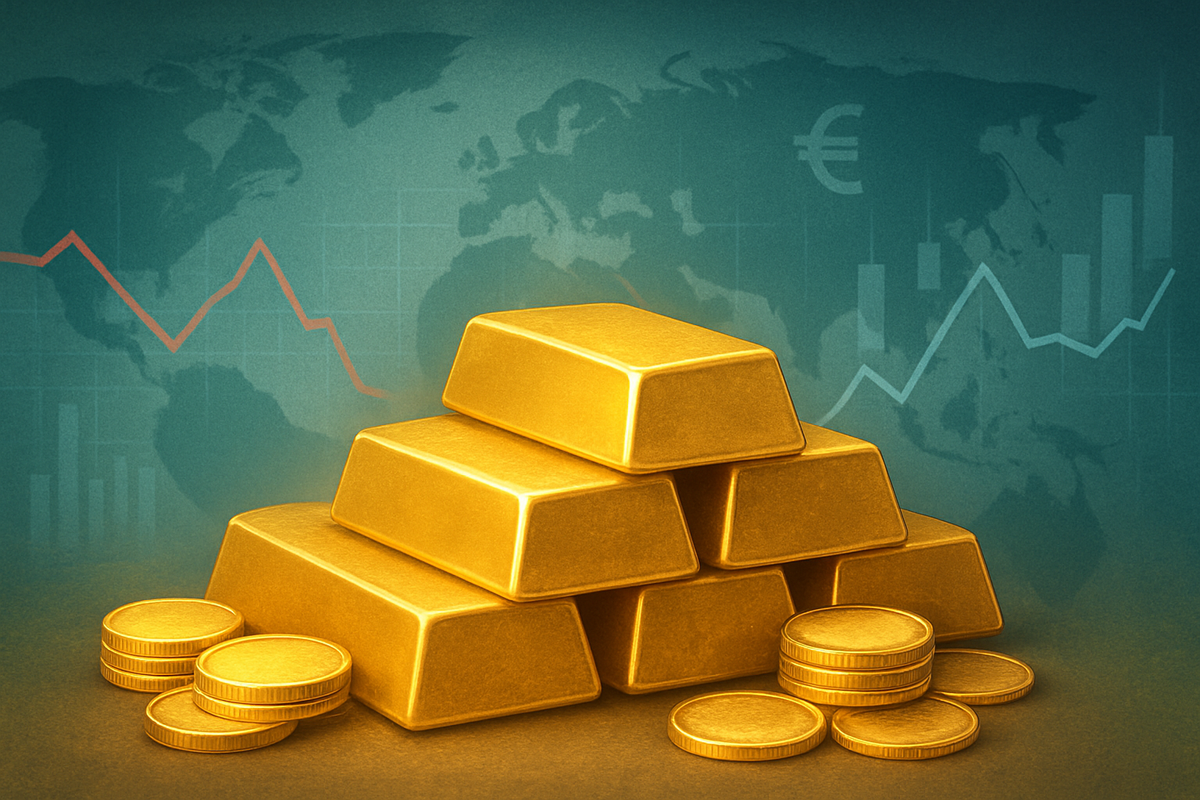
Gold, the traditional safe haven asset, has recently experienced a notable, albeit shallow, pullback from its record highs in late 2025. After soaring to unprecedented levels, the precious metal saw a correction, sparking discussions among investors and analysts about its immediate trajectory. This recent dip, characterized by a decline of approximately 6% from its peak, has been influenced by a confluence of factors, including a stronger US dollar, diminishing expectations of immediate Federal Reserve rate cuts, and nuanced currency dynamics, particularly in emerging markets like India. Despite the short-term volatility, the broader consensus among market experts points towards a sustained bullish trend for gold in the long run, positioning this current correction as a healthy technical adjustment within a robust upward cycle.
A Brief Retreat from Record Peaks: Unpacking Gold's Recent Correction
Gold's recent market activity has been marked by a significant correction following an extraordinary bull run. In October 2025, the yellow metal touched an all-time high of approximately $4,381.58 per troy ounce. However, this peak was met with a sharp reaction, as prices retreated from the $4,200–$4,250 region. The subsequent pullback saw gold fall by roughly $250 per ounce, settling around $4,050 by late October. This correction extended into November, with gold futures initiating a fresh slide around mid-month, shedding about 5.92% within three trading sessions. On November 20, 2025, domestic gold prices in India witnessed a decline of Rs 600, reaching Rs 1,26,700 per 10 grams, while international spot gold slipped to $4,061.53 per ounce. By November 24, 2025, gold showed a modest recovery, rising to $4,076.58 USD/t.oz, up 0.37% from the previous day, indicating some resilience.
The timeline leading up to this moment highlights a remarkable ascent. Gold's current bull market is widely considered to have begun in October 2023, with prices around $2,000 per ounce. Early 2025 saw gold consistently break new records, surpassing $2,900/oz in February and reaching $3,100/OZ in March, driven by US-China trade tensions and a weakening US dollar. By April 2025, prices peaked at $3,500/oz. The second quarter of 2025 continued this trend, with gold hitting $3,352/Oz in June, albeit with frequent intraday spikes and corrections influenced by geopolitical headlines and dollar movements. The significant "rejection" of the October 2025 all-time high on October 21 triggered a "heavy sell-off," marking a clear turning point for the recent correction.
Several key factors converged to influence this recent downturn. A primary driver has been the strengthening of the US Dollar, which typically bears an inverse relationship with gold prices, making the dollar-denominated asset more expensive for international buyers. Furthermore, stronger-than-expected US jobs reports and hawkish signals from the Federal Open Market Committee (FOMC) minutes have tempered market expectations for immediate US Federal Reserve rate cuts. This shift makes non-yielding assets like gold less appealing compared to interest-bearing alternatives. In the Indian context, while the prompt mentioned a "strong rupee" as a factor, market dynamics often show that a weakening Indian Rupee (INR) against the US Dollar actually tends to increase domestic gold prices in rupee terms, as imported gold becomes more expensive. Conversely, a strengthening rupee would likely exert downward pressure on domestic gold prices. Initial market reactions to these pullbacks have been characterized by a period of consolidation, with bulls demonstrating resilience, suggesting that many view this as a temporary correction rather than a fundamental reversal.
Corporate Fortunes: Who Wins and Loses in Gold's Volatile Dance
The recent volatility in gold prices, even if a shallow pullback, has immediate implications for various public companies across the mining, jewelry, and investment sectors. While a sustained decline would undoubtedly challenge gold miners, a temporary correction within a bullish trend presents a mixed bag of opportunities and risks.
Gold mining companies, such as Barrick Gold Corp. (NYSE: GOLD) and Newmont Corporation (NYSE: NEM), might experience some short-term pressure on their stock prices and profit margins during a price correction. Lower gold prices reduce the revenue generated per ounce, potentially impacting their profitability, especially for those with higher production costs. However, if this correction is indeed shallow and followed by a rebound, well-capitalized miners with efficient operations might use this period to optimize costs or even consider strategic acquisitions. Conversely, companies involved in gold exploration, which are more sensitive to investor sentiment, might find it harder to secure funding during periods of price uncertainty.
For jewelry retailers and manufacturers, like Titan Company Limited (NSE: TITAN) in India or luxury brands globally, a dip in gold prices could translate into increased consumer demand, as gold products become more affordable. This might boost sales volumes, particularly during festive seasons. However, these companies also hold gold inventory, and a sharp, unexpected fall could lead to inventory write-downs. On the other hand, a strong rupee, if it makes imported gold cheaper in India, could benefit domestic jewelers by lowering their input costs, potentially improving their margins or allowing them to offer more competitive prices to consumers. Investment firms and ETFs that hold gold or gold-backed assets, such as SPDR Gold Shares (NYSEARCA: GLD), will see their valuations directly tied to the price movements of gold. While a pullback would lead to a decrease in their Net Asset Value (NAV), a bullish long-term outlook could attract new investors looking to buy on the dip.
Broader Implications: Gold's Role in a Shifting Global Landscape
Gold's recent price correction, though significant, must be viewed within the broader context of evolving global economic and geopolitical trends. This event fits into a pattern where gold often acts as a barometer for market uncertainty and inflationary expectations. Its recent surge to record highs was largely fueled by persistent inflation concerns, aggressive central bank gold purchases (particularly from nations like China and India), and ongoing geopolitical tensions globally. The current pullback, therefore, suggests a temporary easing of some of these pressures or a market recalibration of future expectations.
The ripple effects of gold's volatility extend beyond its direct market. A stronger US dollar, a key factor in gold's recent dip, also impacts other commodity prices and emerging market currencies, potentially leading to capital outflows from these regions. Regulatory bodies and central banks will continue to monitor gold's performance as an indicator of systemic financial health and inflation expectations. Historically, gold has consistently served as a hedge against inflation and currency debasement. While the recent dip might challenge this narrative in the short term, the underlying reasons for its long-term appeal—such as its limited supply, status as a tangible asset, and role in diversifying portfolios—remain intact. Comparing this to past corrections, such as those seen after previous bull runs, analysts often note that shallow pullbacks within a strong uptrend are healthy, allowing the market to consolidate gains before the next leg up.
The Road Ahead: Navigating Gold's Future Trajectory
Looking forward, the immediate future for gold prices involves a tug-of-war between lingering hawkish sentiments from central banks and persistent underlying demand drivers. In the short term, investors will be closely watching upcoming US economic data, particularly inflation reports and employment figures, which could influence the Federal Reserve's stance on interest rates. Any further indications of delayed rate cuts or a stronger dollar could exert additional downward pressure on gold. However, many analysts view the current levels as a potential buying opportunity for those with a long-term perspective.
The long-term outlook for gold remains overwhelmingly bullish, according to a consensus of expert predictions for late 2025 and into 2026. Major institutions like JPMorgan, UBS, and Goldman Sachs project gold to not only surpass its recent highs but potentially reach $4,000/oz by mid-2026, with some even forecasting $4,900-$5,000 per ounce by 2026 or 2027. These optimistic projections are underpinned by several enduring factors: continued robust central bank demand, particularly from emerging economies; persistent geopolitical uncertainties which bolster gold's safe-haven appeal; and the anticipated eventual easing of monetary policies by major central banks, which would reduce the opportunity cost of holding non-yielding gold. Potential strategic pivots for investors might include increasing exposure to gold-backed ETFs or physical gold during these dips, while miners might focus on operational efficiency to weather short-term price fluctuations.
Wrapping Up: Gold's Enduring Appeal Amidst Market Flux
In summary, the recent shallow pullback in gold prices, while causing a temporary stir in the markets, appears to be a technical correction within a larger, sustained bull market. The primary drivers for this dip—a stronger US dollar and fading immediate rate cut expectations—are significant but are not seen by most experts as fundamentally undermining gold's long-term value proposition. The interplay of a resilient rupee (with its complex inverse relationship to domestic gold prices) and weak global cues has added layers of complexity to the gold market's current dynamics.
Moving forward, the market is expected to remain highly sensitive to macroeconomic indicators, central bank rhetoric, and geopolitical developments. Investors should maintain a vigilant watch on inflation trends, the trajectory of the US dollar, and the purchasing patterns of central banks. While short-term volatility is likely to persist, the overarching sentiment from financial institutions and analysts is that gold's role as a store of value and a hedge against uncertainty will only strengthen. This recent event underscores gold's inherent responsiveness to global economic shifts, yet reinforces its lasting appeal as a crucial component of a diversified investment portfolio.
This content is intended for informational purposes only and is not financial advice






